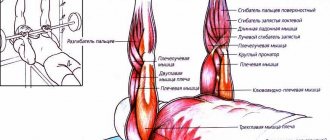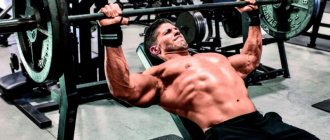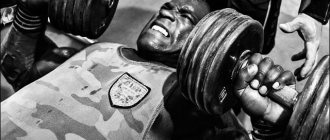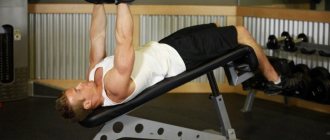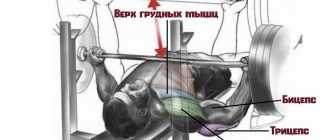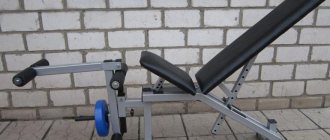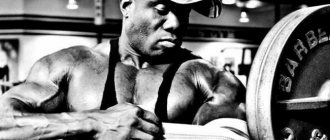The French press is an exercise aimed at working the triceps. It is popular among gym goers, regardless of their fitness level. But despite its apparent technical simplicity, the exercise has a number of features that should be taken into account to obtain results and reduce the risk of injury. Let's look at the technique and features of performing the French bench press with barbells and dumbbells.
- Why do you need to work out the triceps?
- Benefits of the French Press
- French bench press with dumbbells on a bench
- Important nuances
- How to do a French press correctly? Lying arm extension with barbell
- French press with ez-bar: exercise technique
- Advantages of the EZ bar
- How to perform
- Alternatives to the French Bench Press
- Some features and secrets
- Common mistakes
Benefits of the French Press
Basic methods of working out the triceps (close-grip chest press, hanging dips), while effective, require some addition. The shoulder delta, back and chest are inevitably involved in performing these multi-joint exercises.
The French press we are considering isolates the work of the triceps, turning off other muscle groups. Movement is limited at the elbow joint, and this is the main feature of the exercise. As a result, the triceps almost completely takes on the load, which allows you to work it out as efficiently as possible.
French bench press with dumbbells on a bench
Working in this version does not involve the use of a stand, so you will have to lift the projectile from the floor. It is important to do this while following safety precautions to prevent injury.
- Select dumbbells of the desired weight and leave them in front of the bench. Squatting on the edge, pick up the dumbbells and place them on your knees. This will make it more convenient to take the starting position.
- Lie on a bench, raise your arms straight up, holding dumbbells. The arms are parallel to each other, palms facing each other.
- Inhale and, while holding your breath, lower the projectile back and down towards your ears, bending your elbows. All movement is carried out only in the joints of the elbows. The shoulder girdle is fixed.
- Pause for a moment at the bottom, then as you exhale, smoothly return the projectile to the starting position. Your arms should be fully extended.
French press with dumbbells
Important nuances
Using dumbbells allows you to move with greater amplitude, as well as add some variety to the classic technique.
- Variation of the exercise: you can work with each dumbbell in turn.
- To additionally load the triceps, you can slightly turn your hands at the top so that your palms face slightly forward and the dumbbells face each other with their ends.
- To increase the amplitude of the arms, you can tilt them slightly from the shoulder joints to the head.
An exercise using dumbbells is less traumatic than using a barbell: when moving your arms, the joints take a more natural position.
Technique for performing the exercise with a pair of dumbbells
- The two dumbbells should be placed on parallel lines, and the weights should be hung evenly on both sides.
- The starting position will be slightly bent arms with dumbbells above your head, shoulders positioned perpendicular to the floor.
- The dumbbells are pulled behind the head until an acute angle is formed at the elbow. In this case, the shoulders should not change their position.
- Then return to the starting position.
It's best to perform ten repetitions with a light weight to consolidate the technique. After this, with a slightly larger working weight, you should do 3 sets of 10 repetitions.
If your arms are turned incorrectly, the angle of your elbows will be insufficient, which will lead to the ineffectiveness of the exercise.
How to do a French press correctly? Lying arm extension with barbell
A horizontal bench is used for training. It is convenient to work if you have a special stand from which you can take the bar from a lying position. For beginners, it is advisable to use the help of a partner who will back you up while standing behind you.
Comfortable French press rack
To take the starting position, you should sit on a bench lying on your back and take the barbell in your hands with a grip narrower than your shoulders. Fix the position of your hands; further movement will occur only due to bending in the elbow joints.
- The projectile is held with straight arms and slightly tilted towards the back of the head to set the correct trajectory of movement.
- Take a deep breath and, while holding your breath, slowly lower the barbell by bending your elbows to approximately the forehead line.
- As you exhale, begin lifting the projectile by straightening your arms at the elbows. The shoulders are motionless! At the top, pause, feeling the contraction of the working muscle.
Performing a French press using a barbell
When working with a barbell, pay attention to the width of your grip. It is desirable that the distance between the hands be from 20 to 30 cm. If you place your hands narrower, the elbows will move apart when moving, and part of the load will be removed from the triceps. A wider grip will create a risk of injury, as this position is less natural for the joints.
French press with a barbell. Execution options.
It was already mentioned above that the French press with a barbell can be performed standing, sitting and lying down. But these are not all the points that can be changed. You can also take different barbells, with a straight bar and with a curved bar (EZ-bar). Another point is lowering to the nose or behind the head. It is better, of course, to choose the option for the head, since it maximizes the long head of the triceps and has a much greater range of motion. Plus, this technique will be more difficult to perform. And our task is to complicate the training as much as possible, and not to make it simpler (of course, without fanaticism). These are the main points _ a kind of fundamental knowledge about the classification of the French press
French press with ez-bar: exercise technique
Using a curved ez-bar, as in the photo, allows you to reduce the load on your hands.
Neck appearance options
Advantages of the EZ bar
- According to the observations of athletes, the EZ bar is anatomically more comfortable than a straight bar.
- This bar relieves stress on the wrists, thereby reducing the risk of injury and allowing full range of motion.
- Allows for a stronger grip. This makes training safe and allows you to increase working weights without the risk of injury.
- The center of the projectile is clearly marked on the curved bar. The exact location of the central part is a guarantee of the correct technique of the movement being performed.
- The EZ bar can be used by athletes who have had hand injuries in the past.
How to perform
- Sitting on a horizontal bench, use a medium grip to grab the EZ bar at the break point (this will be the center). Straighten your arms above your chest perpendicular to your torso. The elbows are slightly tucked inward.
- Inhaling, slowly lower the projectile to your forehead, bending your elbows.
- Having reached the bottom point, use the force of your triceps to exhale and press the weight upward.
French press with EZ bar
Correct technique for performing a French press
Not only the volume and strength of your muscles, but also the condition of the joints and ligaments that work when performing the movement depends on how clearly you follow the correct technique for performing the French bench press. The French press is just one of those exercises where there is only one factor, if you pay due attention to it, you will certainly achieve success - technique.
And now attention: most gym goers do not have the slightest idea how to properly do a French bench press with a barbell. There are a huge number of mistakes: from the position of the elbows to the placement of the feet.
The French bench press with a barbell is an exercise that puts the greatest load on the long head of our triceps, which, as a rule, responds most heavily to training.
It's all about the correct range of motion: here we can stretch and shorten the long head of the triceps as much as possible. For the greatest stretch, some athletes perform this exercise on an incline bench at an angle of 30-45 degrees. The lateral and medial triceps bundles also receive a sufficient share of the load, due to which a colossal leap in the development of the arm muscles occurs.
Initial position
- First, place the barbell at the head of the bench at a comfortable level for you, or ask your training partner to hand it to you.
- Bend your elbows, carefully grasp the bar with your palms at a distance symmetrical from the center and lift it up, fully straightening your elbows. This is our starting position. The width of your grip depends on what kind of bar you are working with, so in order to diversify the load, I recommend changing the bar from workout to workout: straight, EZ- or W-shaped, all of them are great for the French press.
© lawcain — stock.adobe.com
Barbell bench press
- Smoothly begin to lower the bar down while inhaling smoothly. There are two opinions regarding where the projectile should be lowered: behind the head or to the forehead. I believe that it is more advisable to lower the bar behind your head, as if trying to put it back on the bench, this way we increase the range of motion and focus the load more on the long head of the triceps. However, you should understand that this is not the most convenient exercise from a biomechanical point of view, and you should not strive for huge working weights and neglect the warm-up; take my word for it, injuring your elbow joints and ligaments on the French press is a trifle.
© lawcain — stock.adobe.com
- Once you have lowered the barbell low enough and have properly stretched the long head of the triceps, begin to press the barbell up to the starting position, exhaling powerfully. In this case, the elbows should be in the same position as when lowering, spreading them apart or bringing them inward is unacceptable, and the buttocks, upper back and back of the head should be pressed tightly against the bench. Once you have returned to the starting position, repeat the movement.
If you want to make it more challenging, try doing the French press with a barbell while lying on an incline bench. Ask a gym buddy for help so that he can hand you a barbell; it’s not very convenient to lift it yourself.
The biomechanics of the French press on a horizontal and incline bench are the same, but the slight incline gives us the opportunity to stretch the triceps even more (and put even more stress on the elbow joints and ligaments, remember that too).
For this reason, the French incline press should not be approached with too much zeal or fanaticism, the weights should be moderate, and the movement technique should not be changed. When performing a French press with a barbell on an incline bench, you can slightly lift the back of your head from the bench and bring the barbell behind your head - this way you will add a few precious centimeters to the amplitude of the press and stretch the long head of the triceps even more.
The technique of performing the French bench press with a barbell on a horizontal bench is well demonstrated in this video:
Alternatives to the French Bench Press
Despite the effectiveness of the exercise, in some cases its implementation is undesirable: for example, with an existing injury to the elbow joint. In this case, continue to perform basic exercises that work the triceps:
- close grip bench press
- reverse push-ups
- dips
If performing an isolated load is fundamentally important to you, the French press can be replaced with other single-joint exercises:
- arm extensions in a block simulator
- bent over arm extension with dumbbells
The listed movements do not overload the elbow joints, working the triceps in isolation.
When to Perform the French Bench Press with Dumbbells
Since the exercise is isolating, it must be performed either at the beginning of the lesson or at the end. It all depends on your training method. For example, if you practice using the pre-fatigue method, then you need to do this exercise before the basic ones. And if your workout follows the usual plan, then it is better to leave the French bench press with dumbbells for the end of the session, when all the base is done.
Some features and secrets
The French press is a single-joint isolation exercise, so it is advisable to do it after one of the basic triceps movements, for example, after a bench press with a narrow arm position. This sequence of exercises will allow you to effectively work the target muscle group.
To build triceps mass, do 3 to 5 sets (depending on your physical capabilities) of 8-10 reps each.
If you are working on terrain, do 10 to 15 reps in 3 to 5 sets.
Occasionally, briefly remove the French press from your program and replace it with an alternative triceps isolation movement to give your elbows a rest.
Technique for performing the exercise with one dumbbell
If there is only one dumbbell, it is better to perform the French press on your feet or sitting on a sports bench.
- The dumbbell is lifted up with the right hand, ensuring the shoulder is perpendicular to the floor.
- Then the arm is turned, making the movement of the dumbbells towards the head, and not behind the back.
- It is better to hold the other with one hand so that it does not swing when tense.
- Do 10 lifts with light weights, then do 3 sets of 10 reps with working weights.
Typically, this version of the exercise is performed at the very end of the workout to consolidate previous results. Therefore, you can take very light weights, ask a coach or partner for help, or slightly reduce the number of repetitions per approach.
It is also possible to hold one dumbbell with both hands at once, for this you need:
- Grasp the projectile by one pancake so that it is between the thumbs and index fingers.
- Raise the dumbbell above you, keeping your elbows as close to your head as possible.
- Lower the dumbbell behind your head, then raise it.
- Perform the exercise 10 times as a warm-up or 3 times 10 times as a workout.
This way you can practice both sitting on a bench and standing.
Common mistakes
The apparent technical simplicity provokes athletes, especially beginners, to make mistakes when performing the French press. Here are the most common ones:
- Fast pace . The French press not only works the triceps, but also creates a considerable load on the elbow joints. When the tempo is unjustifiably accelerated, it can simply be shocking. The exercise becomes not only traumatic, but also ineffective, since the force of inertia is activated, and the load is partially removed from the target muscle. Let every movement be slow!
- Manipulations with elbows. Beginners, when lowering the projectile, often take them back and then return them. The exercise becomes similar to a pullover; the load is transferred to other muscle groups. Another common mistake is to flare your elbows out to the sides.
- Change of body position. Do not allow your lower back to lift off the bench. Keep your abdominal muscles tense. During the working approach, the chest should be straightened and the shoulders should be fixed in a straightened position.
- Throwing back the head . This puts unnecessary strain on the neck and increases intracranial pressure, which is undesirable.
- Hull instability. In gyms, you can sometimes see how, when doing a French press, an athlete places his feet on the bench. There is no practical sense in this: the degree of load on the muscle does not change, but maintaining a stable body position becomes more difficult.
- Using too much weight. This does not allow you to perform movements technically correctly and does not give any result other than the risk of injury.
The French bench press is an isolating exercise that effectively works the triceps in a complex workout. It will be effective provided the correct technique is followed. Consider the subtleties and nuances of this seemingly simple exercise: let your training be safe and effective. For more detailed information, we recommend watching a video of this exercise.
French incline press
The French incline press is one of the best exercises for working the triceps. It is effective, quite simple from a technical point of view, and accessible to both beginners and professionals.
Bench Press Variations:
- Traditional - lying horizontally with a barbell or dumbbells;
- On a bench at an angle of 30-45 degrees (vertical);
- On an incline bench, head down at an angle of 30 degrees;
- French bench press with reverse grip.
The incline bench press is a more complicated exercise than the classic one. We recommend that you do not use too much weight on the barbell, otherwise you risk serious joint injuries.
Incline French Press Technique
The exercise should not be performed with heavy weight, the main thing is to fully follow the technique:
- We fix the angle of the bench at 30-45 degrees;
- We lie down on the surface, take the bar in our hands;
- Slightly move your shoulders back (as if bringing your shoulder blades together a little), and move your straightened arms with the bar slightly behind your head;
- We begin work - smoothly lower the bar until reaching 90 degrees at the elbows;
- We do the reverse movement not with a jerk, but powerfully. This happens due to tension in the triceps brachii muscle.
This is a French press technique lying on a bench with your head down. If you want to do this exercise, the technique is slightly different:
- The angle remains the same - about 30-45 degrees, but downwards;
- We raise our arms with the bar above our heads;
- We bend our elbows to the maximum possible slowly and smoothly, and then push the bar out with a powerful movement.
Option for doing a French press with dumbbells:
In both the first and second options, the body should be in the most stable position.
Moreover, the lower back should be pressed tightly against the bench, do not allow bending in the lumbar region to avoid injury.
Features of French presses
There are a number of features:
- What matters is not the inclination of the bench, but the immediate opportunity to move your shoulders a little back, which will allow you to keep the triceps in constant tension without switching the load to other muscles;
- The exercise can only be performed with an EZ bar or dumbbells;
- The bend of the elbow at the extreme point should be no more than 90 degrees;
- Extension of the arms is carried out until they are fully straightened;
- We lower the bar slowly and smoothly, and lift it powerfully and dynamically;
- At the bottom point of the movement, fixation for a few seconds is not required, but at the top, on the contrary, it is welcome;
- Do not forget that you can load the triceps as much as possible only when working with a narrow grip.
The French press cannot be performed with heavy weights at the initial stage. Limit yourself to 10 kilograms. Only after carefully working out the technique can you move on to a more powerful load.
To whom, when and how much
The exercise should be performed:
To whom
For beginners and pros.
When
In the middle of the workout after bench press with a narrow grip. The exercise is basic, it involves all 3 triceps bundles, allowing both beginners and professionals to achieve the desired arm volume.
How many
We recommend 10-12 repetitions x 3-4 sets.
Remember: the exercise is detrimental to the elbow joints - avoid heavy weights.
Masses and relief to you!
